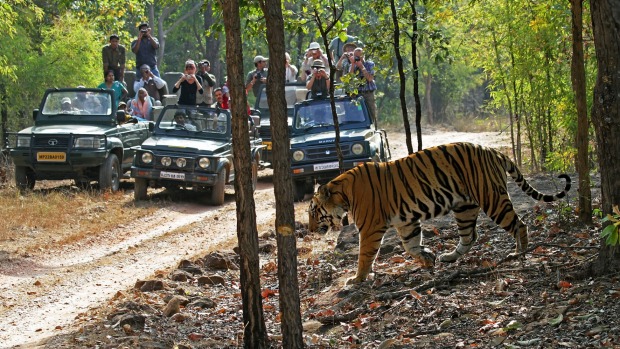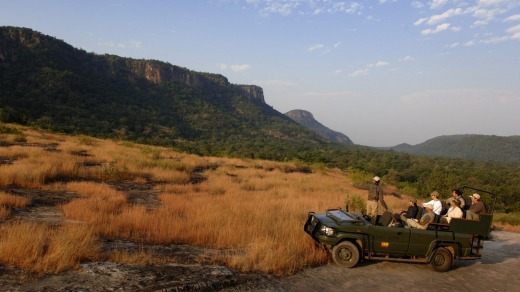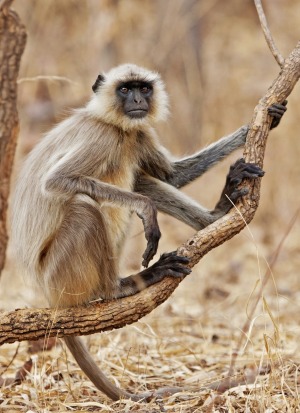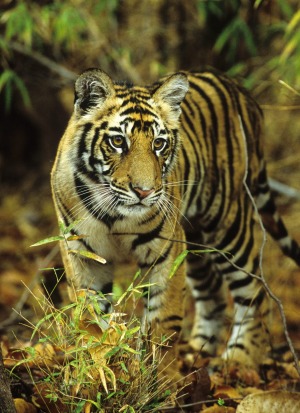
It's jungle opera, front row seats. First, there's the overture – a massive paw track and the imprint of a resting tiger's tail. Then the fresh claw marks on tree bark and a deer's strident alarm call. Finally, it's curtain up – 200 kilograms of Bengal tiger barely a metre away, teeth bared, hunting. Not us, if you please.
We're in India's highland heart, Madhya Pradesh. Sunrise brings a cacophony of calls, barks, whistles and grunts as the theatre that is Bandhavgarh National Park cranks up for the day.
Eyeballing a tiger so close reminds us what our guide, Alwyn da Sousa, has just told us. An injured tiger, upset by a protruding telephoto lens, had attacked two French tourists in 2003, leaping into their jeep. They only survived because she was missing her incisors.

Fear of missing out is palpable as safari vehicles speed around in search of tigers. However much we insist we'll be happy with the deer, the monkeys, the birds, even the sloth bears, we all have a searing desire to see the big cat in the striped pyjamas.
The day before, the trill of the white-throated kingfisher and the nesting blue-chested Indian rollers charmed us; we admired the long-tailed paradise flycatchers, the great rutting racks of the chital (spotted deer), and the peacocks' boastful fans. We were dive-bombed by chocolate-cream langur monkeys, showered with creamy sal flowers, entranced by the fluorescent flame of the forest and the musky scent of mahua blossoms. But there were no tigers.
Anxious guides and grim-faced guests sped around frenetically as rumours spread – sightings, possible sightings, tracks, possible tracks, alarm calls, possible alarm calls, but still, no tigers.

We're on an eight-day Abercrombie & Kent "In Search of Tiger" expedition, at our second safari lodge, Taj Safaris' Mahua Kothi Jungle Lodge, in the 446-square kilometre Bandhavgarh, which has one of the subcontinent's highest tiger densities. With 62 of India's 2250 tigers, Bandhavgarh is our last chance for tiger. The pressure's on.
We'd arrived in India a week ago, launched into dazzling, daunting Mumbai, where slum shacks teeter to three storeys and, in the words of our entertaining A&K guide, Wahid, the local Mumbaikars survive on "good brakes, good horns and good luck".
We're headed for Mumbai's Taj Mahal Palace hotel, with its rich blend of Oriental and European-style architecture, fronting the Gateway of India and the Arabian Sea. We're ushered beneath vaulted alabaster ceilings, past onyx columns, up the cantilever staircase to our water-view Palace Wing room. It's high tea and "street food" in the hotel's Sea Lounge, while the bay outside darkens and flower-covered carriages pulled by horses trip past.

Our first safari destination is Mahua Kothi's southern sister, Banjaar Tola Tented Camp, in Kanha National Park. Bound for Jabalpur, we thank our stars we have Wahid helping us through the bunfight that is Mumbai's domestic airport. A&K has noted: "Adherence to set timings is not the forte of the domestic airlines. Always travel with a good book!" There's a power failure, a computer crash and an endless, amorphic queue, but we make it. Then it's a four-hour drive to Banjaar Tola, whose 18 tented suites hover on raised platforms along the banks of the Banjaar River.
Kanha must be one of the most beautiful of the Madhya Pradesh national parks, 940 square kilometres of pristine wilderness. Sal and bamboo forests combine with open meadows or maidans dotted with herds of chital and sambar. The Bamhni Dadar plateau rises above the forests, which are speckled with the striking Indian ghost tree, or kullu.
Banjaar Tola's suites with private decks are tented extravaganzas. Huge glass doors overlook the river, which you can admire from your circular bed. There are pressed bamboo floors and wall panels, raw timber furniture made from driftwood, canvas and leather tented walls. Nearby, Chattisgarh provides handicrafts, from bastar bell metal structures to tribal metal work. The separate bathroom has double sinks, deep bath with view, rain shower and separate toilet (complete with a tiny frog tucked in the corner).
Then there's Didi – our lovely butler, ever present but non-intrusive. Who scatters the petals along the floor to the bubbling bath? Didi. Who delivers delicious coffee and spiced biscuits into our suite's "butler hatch"? Didi. Who arranges a private candlelit dinner, cooked by magician chefs, Ajit Swain and Adnan Arif, and served on our deck as langurs chitter on the river? You guessed it.
Our naturalist Karun is up against it, however, in the tiger stakes. Early monsoonal rain – terrific when you're tucked in bed and the night lights up with fireworks – has driven the tigers into their lairs. Still, he's informative and entertaining, finding us Kanha's rare barasingha swamp deer, the park's "star birds", the shy gaur or Indian bison, while painting a rich picture of the park's ecosystem. And his traditional Indian sunrise breakfasts laid out on the vehicle bonnet are legendary: salted paratha pancakes with paneer and chutney, pav bhaji rolls with tomato and onion, dosa and kathi rolls stuffed with chicken or vegetables, all washed down by truly delicious coffee.
We're sad to leave, but excited at the prospect of Bandhavgarh's tigers. We must see one before we depart tiger country for the erotic temples of Khajuraho.
A six-hour drive delivers us to Mahua Kothi, where our butler Ram escorts us to one of the 12 private, earth-coloured jungle suites or kutiyas built in the vernacular style of Central India's Madhya Pradesh, known as MP chic.
The suites, with outdoor patios, are hidden among sal and bamboo groves. High-roofed, luxurious and spacious, they are a shuttered sanctuary from the heat.
Everything is oversized – bed, dual basins, dressing room, bath, while the rain shower is large enough to swing a big cat (if you can find one).
Ram is a gem, like Didi. It's no surprise to learn they're friends. Dusty game drives are met by rose-petal bubble baths, trays of gin and tonic, or glasses of delicious local Sula shiraz. A "light lunch" served in our suite morphs into a banquet of tomato and coriander soup, fiery biryani and salad fresh-picked from the vegetable garden.
Bandhavgarh, cradled between the Vindhya and Satpura mountain ranges, is a place of dramatic landscapes, tropical forest, woodlands, rocky hills and grasslands. Spring-fed streams flow into the Son River, which feeds the Ganges. Nestled into the landscape is Mahua Kothi, named for the revered mahua or butter tree.
We're teetering towards the monsoon, the land is fecund, and the mahua is fat with its sought-after aromatic flowers. And as the mahua indulges with its rich crop, so we will be indulged. Head chef Rahul Gupta's Indian dishes, from traditional curries and tandoori to customary khud cooking and spit roasting, are delivered with an elegant, contemporary touch.
Head guide Alwyn joins us for our first thali dinner, familiarising us with the ways of the jungle and the animals: leopard, nilgai, wild boar, chinkara, jungle cat, hyena, porcupine, jackal, fox, and wild dog. And tiger, Alwyn? "I will do my best," he promises.
And he does. Yet tiger sightings are a lottery. Unlike many African safaris, game vehicles are not in radio contact. This is word-of-mouth country and not even mobile phones are allowed. Our tiger-free first day is followed by the jackpot, not just on this day but the next, with basking tigers, bathing tigers, gambolling tigers. Could he perhaps find a Tasmania tiger?
For our first, most exciting sighting, while other guides hoon, Alwyn stops frequently to intently look, listen and smell. Following his jungle clues, he leads us to a young female crunching her kill deep in the bush. We can only make out the flick of an ear and resign ourselves to a modest sighting.
But Alwyn has deduced that other tigers are nearby. Reversing and backtracking, finally, he stops and holds up a hand. There's a crackling sound and out of the jungle she comes – enormous, fluorescent and scary. She glares, snarls, slinks, muscles rippling, and then slides back into the jungle. We look at each other, dumbfounded. Then, from somewhere close comes her parting roar – a huge, hollow sound from deep in the lungs. Owoum! I am tiger. Beware!
HEMIS NATIONAL PARK – SNOW LEOPARD
Trek into the only national park in India north of the Himalayas to try your luck spotting a snow leopard. Hemis, in the Ladakh region of Jammu and Kashmir, offers trekking routes from mid-June to mid-October, but the best time for leopards is late winter. See discoveredindia.com
SUNDERBANS NATIONAL PARK - TIGER
Accessible only by boat, this magnificent park in West Bengal stretches into Bangladesh. It's the only mangrove jungle in the world to have tigers - surprisingly strong swimmers. Visit November to February. See westbengaltourism.gov.in
KAZIRANGA NATIONAL PARK – GREAT ONE-HORNED RHINO
Kaziranga's wide grasslands in Assam, in India's northeast, are where you'll find the world's largest population of Great One-horned rhinoceros. There's lovely birdlife, too. Visit this World Heritage site in late February and March. See assamtourism.gov.in
GIR NATIONAL PARK – ASIATIC LION
Gir, in Gujarat's southwest, has the world's last wild Asiatic lions, hunted almost to extinction in the 1870s. Their habitat previously stretched to Syria in the west and India's Bihar in the east. See gujarattourism.com
NAGARHOLE NATIONAL PARK – ASIAN ELEPHANT
Once the exclusive hunting reserve of the former rulers of the Kingdom of Mysore, Nagarhole, meaning cobra, is home to the largest concentration of Asian elephants in the world. You also might spot tiger, leopard and dhole (wild dog) in its forests. See nagarahole.com
TRIP NOTES
MORE INFORMATION
abercrombiekent.com.au
tajsafaris.com
incredibleindia.org/en
GETTING THERE
Qantas flies daily from Sydney, Melbourne and Brisbane to Mumbai return via Singapore. The Singapore-Mumbai leg is a codeshare with Jet Airways or Air India. See qantas.com.au
TOURING THERE
Abercrombie & Kent's 8-day/7-night "In Search of Tiger" includes accommodation at Taj Safaris' (a joint Taj hotels and &Beyond venture) Banjaar Tola, Mahua Kothi; Mumbai's Taj Mahal Palace; and Khajuraho's Lalit Hotel. Includes game viewing, airport and land transfers, guides, ground support, park fees, breakfast daily and all meals on safari. Available daily except when parks are closed (July to early October). From $4520 (to June 30) per person twin share or $6760 (October-December). See abercrombiekent.com.au